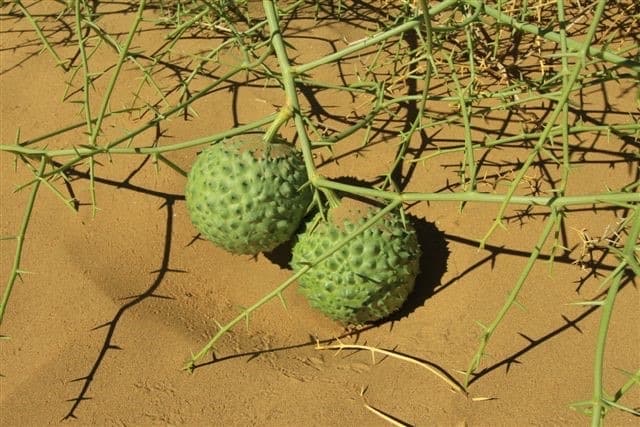Nara oil

Nara oil is extracted from the fruits of the nara, which is a gourd plant belonging to the genus Acanthosicyos and is endemic to Namibia. The correct spelling should actually be !Nara, where the exclamation mark stands for a particular clicking or snapping sound used by the indigenous Damara and Nama ethnic groups. The plant grows on dunes and in intermittent rivers, provided the taproots, which can be up to 40 metres long and 30 centimetres thick, reach the groundwater. It is visually rather inconspicuous and resembles a strongly branched undergrowth. Scientists suspect that the species has existed for many millions of years.
It is the most common plant in the Namib Desert. As a thorny and leafless shrub, the nara can reach heights of one metre. It lives up to 100 years and can cover areas of 1500 square metres. Photosynthesis takes place in the thorns, flowers and branches. Melon-shaped, orange-yellow, spiny berries later form from the flowers that emerge from the armpits of the thorns. They can grow to a weight of one kilogram and reach a diameter of 20 centimetres. Inside are the nutty-tasting, cream-coloured seeds. Nara fruit is a real favourite food for many animals in the Namib.
The rhinoceros eats it just as readily as the hyena, the giraffe and the jackal. The seeds are mainly spread by elephants and porcupines, which excrete them undigested. However, the fruit and seeds are also suitable for human consumption. In Namibia, the plant is also used as a natural sunscreen, for wound healing and against stomach aches.
The extraction of nara oil and its use
To extract the precious nara oil, the locals first travel with their traditional donkey carts to the vast areas between the dunes. They harvest the fruits by hand, cut them in half and scrape the pulp into a drum. The peels are usually fed to the donkeys. Once the drum is filled with pulp, it is heated over a fire, stirring constantly. This succeeds in separating the seeds from the pulp, which becomes more and more liquid. Selling the seeds is an important source of income for the locals. The seeds are carefully dried and sorted by hand. This ensures that only absolutely high-quality and pure seeds are used for further processing. Finally, they are cold-pressed to produce the valuable Nara oil. Special small screw presses are used for this. No chemicals or artificial additives are used. The fact that nara oil is so precious is partly due to the fact that the plant can grow in Namibia without any human manipulation and the fruits are still harvested traditionally. On the other hand, of course, the ingredients also play an important role.
The valuable substances in nara seed oil
Nara oil is rich in unsaturated (omega-6) fatty acids. The proportion of linoleic acid is around 55 percent. Linoleic acid is very important for the water balance of the skin and a well-functioning skin barrier. Nara oil also contains a lot of vitamin E.
This special fatty acid and vitamin combination is particularly suitable for dry and irritated skin. Nara oil is also recommended as an accompanying care for psoriasis and neurodermatitis. Nara oil penetrates deep into the skin and provides a lot of moisture. At the same time, it supports the natural protective function of the skin. In body oil, face cream, body and hand cream, but also in bath salts and peeling, nara oil can optimally unfold its positive properties.
It makes the skin soft and smooth, effectively contributes to regeneration, counteracts painful skin cracks and even serves as an anti-ageing ingredient. After the shower, it can be applied very well to the warm and still damp skin. For a soothing and relaxing massage, the nara oil is briefly warmed between the palms of the hands and then massaged in with a circular motion. It is also very suitable for gentle care of light sunburn.
Nara oil is also suitable for hair care. Irritated scalps are wonderfully soothed and the hair gains a natural suppleness. However, when using nara oil, make sure that it is of high quality and free of parabens, mineral oil, and PEG. Interesting fact on the side: Nara oil has only been used in cosmetics for a few years. Nevertheless, it has already been able to establish itself, because the positive effect speaks for itself.
Nara oil fact sheet
INCI: Acanthosicyos Horridus Seed Oil
Extraction: by cold pressing from the seed of the Nara fruit.
Ingredients: vitamin E, unsaturated fatty acids (especially linoleic acid)
Description: an oily, golden yellow liquid
Effect: calming, regulating, moisturising, supports the skin’s own protective function
Fields of application: for face, hand and body care, for massages and peelings, for hair and scalp care
Nara oil in sophisticated cosmetics from Cosmacon
In Namibia, the Nara plant has been a valuable source of food for humans and animals for thousands of years. Now word has spread about its cosmetic benefits. For those who suffer from dry, chapped, irritated or even cracked skin, nara oil is an excellent choice. The well-tolerated oil contains active ingredients that soothe our skin and provide it with optimal moisture. Cosmacon is happy to support you in the development of high-quality formulations. Just get in touch with us!
Literature:
Characterization of Acanthosicyos horridus and Citrullus lanatus seed oils: two melon seed oils from Namibia used in food and cosmetics applications. Cheikhyoussef N, Kandawa-Schulz M, Böck R, de Koning C, Cheikhyoussef A, Hussein AA.3 Biotech. 2017 Oct;7(5):297
Livestock impacts on an iconic Namib Desert plant are mediated by abiotic conditions. Kerby JT, Krivak-Tetley FE, Shikesho SD, Bolger DT.Oecologia. 2022 May;199(1):229-242